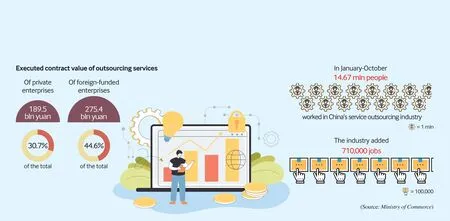THIS WEEK
2022-12-06
SALVAGING THE PAST

A view of the salvaged Yangtze No.2 Ancient Shipwreck in Shanghai on November 21. The wreckage is one of the largest and best-preserved wooden shipwrecks discovered underwater in China so far.
It dates to the reign of Emperor Tongzhi (1862-1875) of the Qing Dynasty (1644-1911). This salvage could offer a useful glimpse into the dynasty’s shipbuilding technology.
Blown Away

The offshore wind turbine with the world’s largest per-unit capacity moves off the production line in Fujian Province on November 23. The equipment, jointly developed by the China Three Gorges Corp. and Xinjiang Goldwind Science and Technology Co. Ltd., symbolizes a breakthrough in high-end wind turbine manufacturing.
Climate Observatory
Shanghai will build a national climate observatory by 2025,according to a report in the newspaperChina Science Dailyon November 23.
The observatory will focus on the main meteorological problems of megacities along estuary areas under the influence of strong human activities, the Shanghai Meteorological Service announced.The observatory is expected to support natural disaster prevention and alleviation, contribute to climate change management and assist the country’s efforts to achieve its carbon peak and neutrality goals before 2030 and 2060, respectively.
Power Line Inspection
Yunnan Province has deployed unmanned aerial vehicles to replace humans in the inspection of its 90,000-km power transmission lines, most of which are in the region’s remote mountains.
During the recent poverty reduction campaign, the border province upgraded grids and extended power supplies to remote villages, but still doesn’t have enough workers for power line inspection.
“Inspecting 100 km of power lines (in Yunnan) takes human workers 20 days but takes a drone just four days,” Gerin Dingdru, a staff member of China Southern Power Grid’s Yunnan branch, said.
The drones are flown automatically, boasting an efficiency five to 10 times higher than flight missions requiring human operators, while the cost is more than halved, Gerin Dingdru added. This makes the practice particularly suitable for Yunnan’s complex landscape and climate.
Since over 80 percent of Yunnan’s power transmission lines are tucked away in high mountains and deep valleys, the power supplier company introduced drone inspections in 2014 but was plagued by a lack of competent operators. It has worked on a route planning system and an automatic piloting system since 2017, facilitating automatic drone inspections.The company said automatic drones now conduct about 65 percent of power line inspections in Yunnan.
Carbon Dioxide Carriers
A Chinese shipbuilding firm has started building two 7,500-cubicmeters liquefied carbon dioxide carriers for Northern Lights, a Norwegian carbon capture and storage project, Xinhua News Agency reported on November 22.Dalian Shipbuilding Industry Co. Ltd., a subsidiary of the China State Shipbuilding Corp., has independently designed and developed vessels for liquefied carbon dioxide shipping.
Each ship is about 130 meters long and 21.2 meters wide. The first ship is scheduled to be delivered in the first quarter of 2024.
The ships—designed to run on dual-fuel consisting of liquefied natural gas and light diesel oil—are commissioned to be used for the European carbon dioxide capture and storage program. They will collect carbon dioxide produced by industries in Europe and transport it to the carbon dioxide reception terminal on the western coast of Norway for processing,before injecting it into the seabed for permanent storage at 2,600 meters deep.
Recovering Knife Fish
Chinese researchers have found that the number of knife fish in the Yangtze River, once a sought-after delicacy and a species afflicted by overfishing, is on the up again thanks to a fishing ban.
Monitoring data from different sections of the Yangtze and sea area adjacent to the river’s estuary show that knife fish resources have been continuously recovering since 2019 when measures were taken to protect the fish, Yang Jian,a researcher with the Freshwater Fisheries Research Center under the Chinese Academy of Fishery Sciences, said.
The knife fish was known as “the first delicacy in the Yangtze,” and its population saw a sharp decrease due to overfishing and the degradation of its natural habitat. China banned the productive fishing of this species in 2019 and a 10-year fishing ban took effect in pivotal waters of the Yangtze in 2021.
Since 2014, Yang and his colleagues have been monitoring a part of the Yangtze-connected Poyang Lake, an area for the knife fish to lay its eggs. Yang said that from 2019 to 2021, the average number of knife fish caught by every observation unit in the area is 67 times that recorded during the 2014-18 period.Areas inhabited by knife fish have been increasing along the Yangtze, and the species was recently found in places such as Dongting Lake and the Ganjiang River where there had been no trace of the fish for more than a decade.
Paleolithic Site
Archaeologists have found a Paleolithic site at the lower reaches of the Bashan Reservoir in Yishui County of Shandong Province,according to the provincial institute of cultural relics and archaeology,Xinhua reported on November 21.They said the site, located 300 meters downstream from the flood discharge gate of the reservoir,could date to the middle or late Paleolithic period. According to the collected fossils and stone product specimens, experts deduced the site could date back roughly 30,000 to 50,000 years.
The site contains many animal fossils, flints and quartz products,according to the provincial institute of cultural relics and archaeology.
The fossils are mostly large vertebrate paleontology, antlers,and cattle teeth. The stone products include stone cores, stone chips and scrapers.
Based on these stone tools,it can be determined that this site contains not only paleontological fossils, but also evidence of early human life, dwellings, and chipped stone tools. The discovery is of great significance to the study of ancient human activities in Shandong, according to the institute.
Space Challenges
Chinese space scientists and engineers published 10 science and technology challenges in the field of astronautics for 2022 at the China Space Conference in Haikou,capital of Hainan Province, from November 21 to 24.
This list of challenges includes power acquisition from cosmic dynamics, the search for habitable exoplanets and signs of life, key technologies for a shuttle-like space transport system, the monitoring of and defense against near-Earth asteroids, and the development of artificial light synthetic materials for extraterrestrial subsistence.
Long-distance, high-power wireless energy transfer technology, in-situ construction on the surface of the moon utilizing regolith, trans-media aircraft control, collaborative work on space constellation, and highprecision prediction of Earth’s upper atmospheric flow field evolution, are also mentioned on the list as problems to crack in space exploration.
The list will “play a positive,supporting role to China’s research in basic science and the country’s advances in engineering projects,”Wang Wei, Director of the Research and Development Department under the China Aerospace Science and Technology Corp., added.
Solar Image
China’s solar exploration satellite has transmitted its first solar image since being sent into space in October, according to the Purple Mountain Observatory (PMO)based in Jiangsu Province.
The Advanced Space-Based Solar Observatory—nicknamedKuafu-1in Chinese—sent hard X-ray imaging of solar flares that broke out at 1:00 a.m. (Universal Time) on November 11, Gan Weiqun,the satellite’s principal scientist from PMO under the Chinese Academy of Sciences, said.
Gan said the image was taken by the satellite-loaded hard X-ray imager. Although still in the testing stage, the imaging quality is excellent, allowing the effective identification of both the eruptive details and the fine structure of the sun.
Kuafu-1was launched aboard a Long March-2D rocket on October 9 from the Jiuquan Satellite Launch Center in northwest China.
An Artsy Lifestyle

Oil paintings at a gallery on the “oil painting street” of Tunchang, a county in Hainan Province on November 21. The county is known for its oil paintings.
A Milestone

A China-Europe freight train leaves from Xi’an International Port, Shaanxi Province, for Europe on November 23. The train, fully loaded with home appliance products, was the 4,000th China-Europe freight train to depart from Shaanxi in 2022.
Transport Investment
Fixed assets investment in road and waterway transport reached nearly 2.47 trillion yuan ($345.5 billion) in the first 10 months of 2022, up 9.5 percent year on year,the Ministry of Transport said.
Within this total, 2.34 trillion yuan ($327.6 billion) went to road transport projects, up 9.6 percent year on year; 63.4 billion yuan ($8.8 billion) to inland waterway projects, an increase of 9.2 percent; and 65.2 billion yuan($9.1 billion) to coastal waterway projects, gaining 8.2 percent.
Industrial Economy
Industry, region and enterprisespecific measures will be adopted to secure the sound development of key industries,boost coordinated regional development, and inject vitality into industrial enterprises, according to a document jointly issued by the Ministry of Industry and Information Technology,the National Development and Reform Commission, and the State-Owned Assets Supervision and Administration Commission of the State Council on November 21.
Efforts will be made to tackle key issues facing the industrial economy, including accelerating the construction of major projects to generate increased physical gains, tapping into market potential to grow consumer demand, stabilizing exports of industrial products,improving the resilience and security of industrial and supply chains,and fostering new growth drivers,it said.Another priority highlighted is to guarantee sufficient supplies of energy and raw materials to maintain the stable operations of key industrial and supply chains.
Financial Openness
China’s financial sector has entered a new phase of highstandard opening up, the head of the country’s top banking and insurance regulator said on November 21.
Since 2017, the assets of foreign banks in China have increased by nearly 30 percent, and the assets of foreign insurance companies in China have expanded by roughly 120 percent, Guo Shuqing, Chairman of the China Banking and Insurance Regulatory Commission, said at this year’s Financial Street Forum annual conference.
“We will, as always, welcome foreign financial institutions that have sound operations, good qualifications and outstanding specialties to participate in the Chinese market,” Guo said.
SOE Growth
Centrally administered stateowned enterprises (SOEs) saw steady growth in revenue and profit in the first 10 months of the year despite downward pressure, according to the State-Owned Assets Supervision and Administration Commission of the State Council.
The companies raked in 32.3 trillion yuan ($4.5 trillion) in combined revenue in the period, up 9.9 percent from the same period last year, the commission said.
Their net profits reached 1.7 trillion yuan ($238 billion), up 3.9 percent year on year.
Investor Requirements
Financial authorities have released regulations to optimize fund management requirements for foreign institutional investors in China’s bond market.
The regulations, effective from January 1, 2023, were jointly released by the People’s Bank of China and the State Administration of Foreign Exchange to facilitate the opening up of the domestic bond market.

The regulations set out unified requirements for the management of foreign institutional investor fund accounts, statistical monitoring, and the receipt, payment and exchange of funds.
They have also optimized the management of spot foreign exchange settlements and sales, as well as refined foreign exchange risk management policies.
Under the regulations,foreign institutional investors will have more channels for foreign exchange hedging and the limit on the number of counterparties in over-the-counter transactions will be removed.
The rules also make it easier for foreign institutional investors to remit investment funds, and aim to encourage long-term investment in China’s bond market.
Growing ODI
China’s non-financial outbound direct investment (ODI) reached 627.4 billion yuan ($87.8 billion)in the first 10 months of 2022, up 10.3 percent year on year, official data showed on November 17.
In U.S. dollar terms, the ODI rose 7.3 percent from last year,according to the Ministry of Commerce.
Outbound leasing and business services investment rose 22.2 percent compared with the same period of last year to reach $32.08 billion this year.
Investment in multiple fields,including manufacturing, wholesale and retail and construction,registered growth.
In the first 10 months, nonfinancial direct investment in countries along the Belt and Road routes increased 6.7 percent year on year to $17.25 billion,accounting for 18.3 percent of the total ODI during the period.
Future Industries
Output of Shanghai’s future industries is expected to reach roughly 500 billion yuan ($70 billion) by 2030, according to local authorities.Wu Jincheng, Director of the Shanghai Municipal Commission of Economy and Information Technology, said on November 23 the city will focus on boosting future health, smart technology,energy, space and materials industries, given global technological and industrial advances and Shanghai’s advantages in industrial innovation and development.
An action plan for promoting future industries was also released,which proposed building five future industrial clusters.
The city aims to build about 70 hydrogen refueling stations and three to five innovative research and development platforms by 2025. The number of hydrogen fuel cell vehicles will exceed 10,000, and the industrial scale of the hydrogen energy industry chain will exceed 100 billion yuan ($14 billion), the action plan said.
Huawei’s Commitment
Chinese tech giant Huawei has joined the Partner2Connect(P2C) digital coalition of the International Telecommunication Union (ITU), company Chairman Liang Hua said on November 23.
Huawei is committed to helping 120 million people in remote areas connect to the digital world by 2025, Liang said at the 2022 Sustainability Forum.
The event explored how innovation in information and communications technology could unleash business and social value in the era of the digital economy.
Cao Ming, President of Huawei Wireless Solutions,said the company has continuously upgraded its RuralStar and RuralLink solutions to extend quality coverage to remote areas.The RuralStar solutions has provided connections for more than 60 million people in remote areas in more than 70 countries.Huawei said it will begin working with government departments and universities in Cambodia, the first P2C partner country of the ITU, to provide 10,000 training opportunities for professionals in the next five years.



TRAILBLAZING TRIBUNAL JUDGES
The 77th UN General Assembly on November 15 elected two Chinese candidates to become judges of the UN Appeals and Dispute tribunals. It’s the first time since the establishment of both bodies—in 2008 and 2009—that nominees from China have been elected.
Gao Xiaoli of China’s Supreme People’s Court was elected judge of the Appeals Tribunal for a term starting upon appointment and ending on June 30, 2026.
The Dispute Tribunal in Geneva, Switzerland, elected Sun Xiangzhuang, also of the Supreme People’s Court, as judge for a term from July 1, 2023 to June 30, 2030.
Both organs are important bodies of the UN internal justice system, playing a key role in safeguarding the legitimate rights and interests of UN staff members and promoting the effective functioning of the UN system based on the rule of law.

Live Performance of
Traditional Operas
Eastday.com
November 18
On November 7, a live-streamed performance of Huju Opera, a variety of Chinese opera sung in Shanghai dialect, attracted over 550,000 online views in just its first hour of broadcast.
The high art of traditional Chinese operas seems far removed from commercial concerns. Yet money matters. Merely focusing on passion and pure artistic feeling is not enough to retain high-caliber talents, let alone attract newcomers. To make people want and be able to stay, the industry must be able to guarantee a stable source of income.
With live performances currently unfeasible, traditional Chinese operas have found a new source of income through online streaming. Unlike on a physical stage, online performances are free from temporal and spatial limits: An online performance can be watched anytime, anywhere. In the long run,as the art form continues to attract more talent and followers, a positive feedback loop will emerge.
On the other hand, no matter how hypermodern the promotional strategies are,traditional Chinese operas should always maintain their aesthetic principles that pursue not an imitation of reality but an expression of their essences and a vault of traditions that time itself has deposited.
“The escalation of tension on the Korean Peninsula is not in the interest of any party, and it is also what China does not want to see.”
Zhang Jun, China’s Permanent Representative to the UN, at a Security Council meeting on November 21
“In the complex realm of space exploration, international cooperation will undoubtedly be the best practice for success.”
Niklas Hedman, Acting Director of the UN Office for Outer Space Affairs, at the 2022 UN/China Second Global Partnership Workshop on Space Exploration and Innovation which ran from November 21 to 24

Multilevel Manufacturing
Oriental Outlook
November 10
The concept of industries “going upstairs” describes the movement of industry into multi-story complexes that integrate research and development,factories, offices, warehouses, and recreational areas into vertical spaces.
This new kind of architectural design arises from China’s pressing need for a more efficient use of industrial land. The country’s vast population means a comparatively low per-capita availability of land, which is unable to meet the demand of the rapidly expanding manufacturing sector.
It was against this backdrop that a new, stacked-up style of industrial land use emerged in 2012 in the Pearl River Delta, a manufacturing hub in Guangdong Province,densely populated with industrial parks.The first of the delta’s industrial areas to test this style was the Quanzhi Technology Innovation Park in Shenzhen. Once a cluster of low-end hardware stores, dye makers and packaging companies, the park has transformed itself into a hi-tech hub housing robotics companies and smart device brands,and a modern complex accommodating research and manufacturing facilities, living quarters, and even an art museum.
This new setup was quickly adopted by industrial parks in the Yangtze River Delta and the Bohai Economic Rim, another two industrially advanced regions of the country. Though a national standard for these factory complexes is yet to be established, the vertical integration of enterprises into whole industrial chains within buildings has already started to form. Unlike traditional stand-alone factories, these complexes are deliberately planned to accommodate companies clustering around the same supply chain.A natural circulation of technologies and customers is thereby created among businesses located in the same building.
The strategic planning that comes with these new industrial spaces also allows a more selective composition of registered companies.
Facing New Technologies
Beijing Daily
November 18
A man in Zhenhai District in Ningbo,Zhejiang Province, recently filed suit against his residential compound for the installment of a facial recognition system. The dispute ended in a court decision requesting the defendant to delete all biometric information collected from the residents.
This case teases out a larger question:How should the application of new technologies be balanced with the protection of privacy? One cannot simply deny the revolutionary capacities of facial recognition in making authentication simpler and more secure, yet legal boundaries must be put in place to regulate the use of this new technology.
The Supreme People’s Court, China’s top judicial authority, has published provisions stating that any unauthorized collection of facial recognition data by commercial entities is an infringement of personal interests, a civil offence that allows the victim to appeal to the law for justice.
Technology should always serve humanity and leave its users the choice to switch to other alternatives at will.
Therefore, for new technologies to be widely recognized, the key is to respect ethical boundaries and leave some room in which other products can thrive.
A PADDLE PUSH FOR ASIAN GOLD
Wang Yidi claimed the women’s singles title at the 2022 Table Tennis Asian Cup on November 19.
After beating world No.6 Hina Hayata 4-1 in the semifinal, top-seeded Wang entered a final clash with Mima Ito, who defeated India’s Manika Batra 4-2 to advance.
Wang pulled off an 11-8 victory in the sixth set to secure her maiden Asian Cup trophy. This is China’s fifth straight title in the women’s category since 2016.
Born in Anshan City of Liaoning Province in 1997, Wang started learning table tennis in primary school. At the age of 16,she secured a spot on the national team.
Wang currently ranks No.4 on the International Table Tennis Federation world ranking for female players.

“The fact that developed and major industrial countries have admitted the damages they have caused to the environment is big progress.”
Magdy Allam, Secretary General of the Arab Federation for Environmental Experts affiliated with the Cairo-based Arab League, in an interview with Xinhua News Agency on November 20
“The current economic operation indicates that we have handled our macroeconomic policy appropriately.”
Yi Gang, Governor of the People’s Bank of China, the country’s central bank, at the annual conference of the Financial Street Forum on November 21
